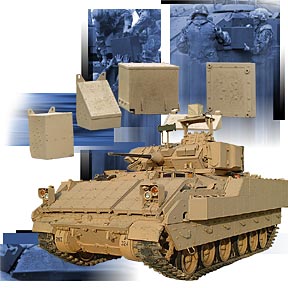The latest death toll figures from Hurricane Katrina can be seen on this website here. The famous Russian neo-Nazi video is on this blog here.
The original version of this video is here.
The much-vaunted US Abrams tank is said to be the best tank in the world. US forces brag that they cannot even kill one with US anti-tank weapons. Indeed, the Abrams may be the best tank in the world. However, that does not make it indestructible, as this video shows.
The weapons used here were probably large anti-tank mines (up to 1000 pounds), anti-tank missiles, RPG's and roadside bombs. The Abrams seen in 2:35 in the video was killed north of Baghdad near Duluiyah a couple of years ago; 2 US soldiers were killed and 1 more was terribly wounded.
The weapon was three 150-pound anti-tank mines laid on top of each other and all detonated at once. Despite the seemingly terrible toll on the tanks in this video, it is probable that few crew members were killed in these attacks.
The notation at one point in the video about the "Sabot" round is probably incorrect - that is quite possibly NOT a Sabot round in that photo. A sabot round is fired from a gun or possibly another tank. It travels at about 1 mile/second and often uses a depleted uranium tip to penetrate the tank.
It is a truly nasty round that once it gets inside tends to spray shrapnel everywhere and scramble most material inside the tank, including the tank's most sensitive inner workings. It is dubious that the Iraqi guerrillas have any DU rounds.
 A sabot round in action. It doesn't appear to be much but the thing in the center is a depleted uranium round that is capable of causing an awful lot of damage. Believe it or not, that round probably sounds like a freight train going by if it's fired anywhere in your direction.
A sabot round in action. It doesn't appear to be much but the thing in the center is a depleted uranium round that is capable of causing an awful lot of damage. Believe it or not, that round probably sounds like a freight train going by if it's fired anywhere in your direction.****
The bottom and top of the Abrams are not nearly as armored as the sides. The rear is also vulnerable as this is where the engine is. The engine can be taken out with a good shot to the rear, even with a lowly RPG-7. A few of the photos appear to show Abrams that have fallen off the road into ditches or sunk in the mud. See 1:52 in the video.
Despite its excellence, the Abrams has been around for some time now. Work on it began in the 1970's and the first one came online in 1980. It has been upgraded several times since then. Each Abrams costs $2.3-4.3 million. The latest is the M1A2, with a 120mm smooth-bore turret that fires its own sabot rounds.
A 500-1000 pound "gravity bomb" will blow an Abrams to smithereens. The US has been dropping a lot of bombs on Iraq these days and surely not all of them are exploding. The Iraqi guerrillas may be finding these bombs on the ground and fashioning them into anti-tank devices.
The things on the sides of the tank at 1:23 in the video that look like tiles are reactive armor. Reactive armor actually explodes much weaponry that attacks it. That is, the weapon hits the reactive armor, and the reactive armor detonates the weapon on the armor, so the weapon cannot penetrate inside the tank.
 Reactive armor on a tank. The panels above the tank are panels of reactive armor. Reactive armor is capable of defeating a shaped charge. A shaped charge sends out a warhead of molten magma that is not really a formed object. This magma can usually get only partway through the reactive armor before the reactive armor detonates, reducing much of the impact of the shaped charge.
Reactive armor on a tank. The panels above the tank are panels of reactive armor. Reactive armor is capable of defeating a shaped charge. A shaped charge sends out a warhead of molten magma that is not really a formed object. This magma can usually get only partway through the reactive armor before the reactive armor detonates, reducing much of the impact of the shaped charge.The explosive force penetrator described below is more worrisome because it is an actual metal object that become warped into a shaped charge. This object is somehow able to make its way through the reactive armor without the reactive armor detonating it.
****
However, a 2-stage device can defeat reactive armor. The device initially detonates on the armor, and then a secondary shaped charge detonates that is capable of penetrating the armor. The newer anti-tank weapons, especially the Russian weapons used by Hezbollah in the Lebanon War, can definitely defeat reactive armor. Such weapons include the Russian AT-7 Saxhorn, the Italian MILAN and the Russian RPG-29.
The reactive armor on the Abrams may be up to one foot thick. The reactive armor itself is made of U-235, or depleted uranium. When an Abrams tank starts burning, it will give off DU in its smoke, which is very toxic. Also, the Abrams itself fires DU in its rounds.
The US media is making much of the supposedly Iranian explosive force penetrator bombs that according to the US military itself can destroy an Abrams tank. It's similar to a shaped charge.
In general, the Abrams, like the similar Israeli tank called the Merkava, is best suited to the plains of Europe or open deserts in set piece battles with other tanks and armor. In close quarters fighting, such as Israel was doing in Lebanon and the US is doing in Iraq, tanks do not work so well.
In particular, in such situations it is necessary to support the tanks with a lot of infantry, something that Israel was not doing in the Lebanon war, probably because they wished to minimize losses to their infantry. And the infantry should be with the tanks - having tanks moving in front of infantry makes tanks vulnerable.
In short, in today's urban guerrilla conflicts against foes hiding in populated, built-up areas with plenty of cover to conceal themselves, and without proper support for the tanks, tanks are a diminishing military asset, even the best tank in the world, the Abrams tank.
Especially regarding the Lebanon War, it seems that we are back to World War 2, where tanks must be supported by infantry teams and other arms in order to take out anti-tank squads. Tanks are simply not meant to be used in close quarters fighting against infantry, and this is how Israel used them in the Lebanon War. In part this is due to their limited visibility, a real problem in urban combat.
Dug-in/underground/camouflaged anti-tank teams need to be taken out with infantry, not the tanks that they are attacking. One possibly way to defeat this would be for anti-tank teams to hide while they are overrun and then attack the second-wave armor from behind. However, it is possible that the teams may die with such near-suicidal tactics. Remote-controlled anti-tank mines will always be a danger for any tank.
We should note, though, that the Merkava has significantly inferior armor compared to the Abrams, though the Merkava is also a superb tank. The armor on the Abrams is referred to as Chobham armor. The original US Chobham armor has been upgraded to where the new Chobham armor is significantly better than the original Chobham armor.
The Merkava was probably based on the US M60 design. During the 1973 war, against strong Congressional opposition, the US, namely Henry Kissinger, rushed replacement M60 US tanks to the Israelis. The Israelis probably up-engineer a number of M60's until they eventually developed the Merkava.
The Merkava is not an M60 knockoff, however, since it differs in some important ways, in particular, in having a troop-carrying compartment at the back of the vehicle.
In the Lebanon War, Hezbollah used a variety of anti-tank weapons, in particular the Russian-made 9M113 Konkurs. This weapon has the US military very worried. An excellent overview of the Spandrel is here. The Spandrel is the equivalent of the US TOW missile (linked below), considered to be one of the best anti-tank guns around. It can hit a target at an incredible 2 1/2 miles.
Hezbollah may have also used some of the newer Kornets or others in the AT-series, including Chinese variants.
An AT-3 Sagger would probably need to hit a Merkava right on top to take it out. The newer anti-tank weapons such as the AT-14 Kornet (reportedly re-engineered by the Iranians), the TOW-3 and the Javelin are designed for top attack. Hezbollah may also have used the Milan anti-tank weapon, an excellent weapon that Croatia used to great effect during the Balkan Wars.
Note: Readers should carefully read the Commenting Rules before commenting to avoid having their comments edited or deleted and to avoid being banned from the site.



No comments:
Post a Comment